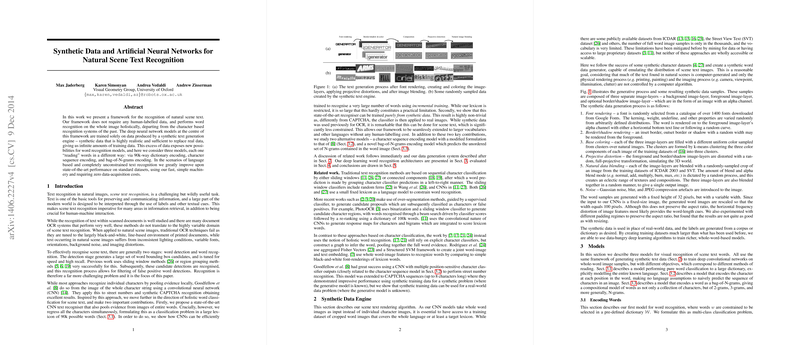Synthetic Data and Artificial Neural Networks for Natural Scene Text Recognition
The paper presented by Jaderberg et al. introduces an innovative framework for natural scene text recognition. This framework is distinguished by its reliance on synthetic training data, effectively eliminating the need for human-labeled datasets. The core of their approach is the use of deep neural networks that perform holistic word recognition from entire images, marking a departure from classical character-based recognition systems.
Methodology
The central aspect of this work is the use of a synthetic text generation engine to create realistic training data. This system can produce infinite amounts of data that mimic the variability found in natural scenes. Such synthetic data allows for significantly larger and more versatile training sets than are typically feasible with manually labeled data.
Three distinct recognition models were explored:
- 90k-way Dictionary Encoding: This model treats word recognition as a multi-class classification problem, with each word in a 90,000-entry lexicon corresponding to an output class. A convolutional neural network (CNN) with incremental training is employed to handle the large number of classes effectively.
- Character Sequence Encoding: Unlike the dictionary-based model, this approach predicts the sequence of characters in a word. The word length is fixed at 23 characters, with a null character assigned to unused positions. This model operates without a predefined lexicon, offering completely unconstrained text recognition.
- Bag-of-N-grams Encoding: This novel model recognizes words by predicting the occurrence of N-grams (substrings of length N). The output is a composite representation of N-grams that constitute the word, which can then be mapped back to a word in the lexicon using nearest-neighbor or SVM classification techniques.
Synthetic Data Generation
The synthetic text generation process involves several steps to ensure realism, including font rendering, projective distortions, noise addition, and natural image blending. This sophisticated pipeline ensures that the generated images closely replicate the variety and complexity found in natural scenes.
Evaluation
The models were assessed on multiple benchmark datasets such as ICDAR 2003, ICDAR 2013, Street View Text (SVT), and IIIT 5k-word. Several test scenarios, including lexicon-constrained and unconstrained recognition tasks, offered a comprehensive evaluation of the models' capabilities.
Results
The dictionary encoding model achieved exceptionally high recognition accuracy. For instance, when using a lexicon constrained to test set words, the accuracy reached 99.2% on the ICDAR 2003 dataset and 96.1% on SVT. Even with expanded dictionaries (50k and 90k words), the models maintained strong performance, albeit with a slight drop in accuracy.
The character sequence model, while slightly lower in overall accuracy, excelled in flexibility due to its unconstrained recognition capability. The bag-of-N-grams model, particularly when combined with a simple linear SVM, also demonstrated competitive performance, showing the effectiveness of using compositional representations for text recognition.
Implications
The primary theoretical implication of this research is the validation of synthetic training data as a viable substitute for real annotated datasets. Practically, this approach drastically reduces the cost and effort associated with dataset curation, enabling scalable and efficient development of robust text recognition systems. The ability to generate infinite amounts of high-quality training data opens new avenues for deep learning applications in text recognition and beyond.
Future Directions
Future research could explore more advanced synthetic data generation techniques, potentially incorporating generative adversarial networks (GANs) for even greater realism. Additionally, fine-tuning and domain adaptation strategies could be investigated to bridge any residual gap between synthetic and real data performance. Combining these models with more sophisticated LLMs could further enhance recognition accuracy, particularly in unconstrained settings.
In conclusion, Jaderberg et al.'s work represents a significant advancement in the field of natural scene text recognition. By leveraging synthetic data and innovative neural network architectures, they have set new benchmarks for accuracy and efficiency, paving the way for future developments in AI-driven text recognition systems.
